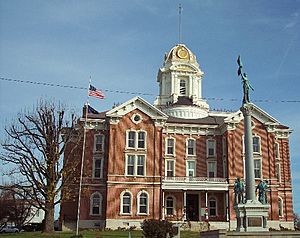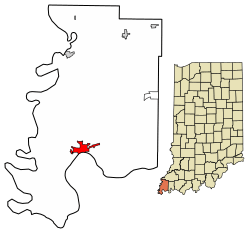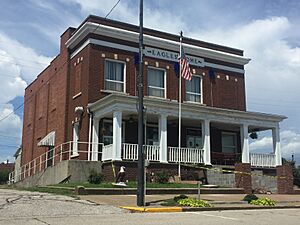Mount Vernon, Indiana facts for kids
Quick facts for kids
Mount Vernon, Indiana
|
|
|---|---|
| City of Mount Vernon | |

Posey County Courthouse
|
|

Location of Mount Vernon in Posey County, Indiana.
|
|
| Country | |
| State | |
| County | Posey |
| Township | Black |
| Founded | 1816 |
| Incorporated | 1832 |
| Area | |
| • Total | 2.92 sq mi (7.56 km2) |
| • Land | 2.88 sq mi (7.45 km2) |
| • Water | 0.04 sq mi (0.11 km2) 1.75% |
| Elevation | 413 ft (126 m) |
| Population
(2020)
|
|
| • Total | 6,493 |
| • Density | 2,256.08/sq mi (871.13/km2) |
| Time zone | UTC-6 (CST) |
| • Summer (DST) | UTC-5 (CDT) |
| ZIP code |
47620
|
| Area code(s) | 812, 930 |
| FIPS code | 18-51732 |
| GNIS feature ID | 2395128 |
| Website | http://www.mountvernon.in.gov/ |
Mount Vernon is a city in the state of Indiana, United States. It is the main city and county seat of Posey County, Indiana. This means it's where the county government offices are located.
Mount Vernon is in the far southwestern part of Indiana. It's very close to the state's southernmost and westernmost points. In fact, it is the westernmost city in Indiana.
In 2010, about 6,687 people lived here. Mount Vernon is part of the larger Evansville, Indiana, metropolitan area. This area had a population of 358,676 people in 2010.
Contents
History of Mount Vernon
Mount Vernon is the biggest city in Posey County. The county is named after General Thomas Posey. He was a governor of the Indiana Territory a long time ago.
The first person to settle in Mount Vernon was Andrew McFaden in 1806. Back then, the settlement was called McFaden's Bluff. The city was officially planned and named Mount Vernon in 1816. However, some people still called it McFadden's Bluff for a while. It was named after George Washington's famous home, Mount Vernon. A post office has been open here since 1818.
Historic Places in Mount Vernon
Several places in Mount Vernon are recognized for their history. They are listed on the National Register of Historic Places. This is a list of important historical sites in the United States. Some of these places include:
- Posey County Courthouse Square
- Mount Vernon Downtown Historic District
- Welborn Historic District
- William Gonnerman House
Geography and Climate
Mount Vernon covers about 2.86 square miles (7.41 square kilometers). Most of this area is land, with a small part being water.
What is the Climate Like?
Mount Vernon has a type of weather called a humid subtropical climate. This means it has hot, humid summers. The winters are usually mild to cool.
| Climate data for Mount Vernon, Indiana (1991–2020 normals, extremes 1893–present) | |||||||||||||
|---|---|---|---|---|---|---|---|---|---|---|---|---|---|
| Month | Jan | Feb | Mar | Apr | May | Jun | Jul | Aug | Sep | Oct | Nov | Dec | Year |
| Record high °F (°C) | 73 (23) |
78 (26) |
90 (32) |
91 (33) |
98 (37) |
106 (41) |
109 (43) |
104 (40) |
107 (42) |
96 (36) |
84 (29) |
77 (25) |
109 (43) |
| Mean maximum °F (°C) | 62.3 (16.8) |
67.7 (19.8) |
75.0 (23.9) |
81.9 (27.7) |
87.8 (31.0) |
93.7 (34.3) |
95.4 (35.2) |
95.1 (35.1) |
92.8 (33.8) |
84.7 (29.3) |
73.1 (22.8) |
65.0 (18.3) |
97.3 (36.3) |
| Mean daily maximum °F (°C) | 41.6 (5.3) |
46.0 (7.8) |
55.5 (13.1) |
67.4 (19.7) |
76.7 (24.8) |
85.0 (29.4) |
87.9 (31.1) |
87.3 (30.7) |
81.6 (27.6) |
70.3 (21.3) |
56.6 (13.7) |
45.9 (7.7) |
66.8 (19.3) |
| Daily mean °F (°C) | 32.3 (0.2) |
35.9 (2.2) |
44.7 (7.1) |
55.5 (13.1) |
65.6 (18.7) |
74.4 (23.6) |
77.3 (25.2) |
76.0 (24.4) |
69.4 (20.8) |
57.9 (14.4) |
45.9 (7.7) |
36.6 (2.6) |
56.0 (13.3) |
| Mean daily minimum °F (°C) | 22.9 (−5.1) |
25.7 (−3.5) |
33.8 (1.0) |
43.7 (6.5) |
54.4 (12.4) |
63.7 (17.6) |
66.6 (19.2) |
64.7 (18.2) |
57.3 (14.1) |
45.4 (7.4) |
35.3 (1.8) |
27.3 (−2.6) |
45.1 (7.3) |
| Mean minimum °F (°C) | 5.5 (−14.7) |
11.3 (−11.5) |
19.4 (−7.0) |
32.0 (0.0) |
42.9 (6.1) |
54.2 (12.3) |
60.4 (15.8) |
58.0 (14.4) |
45.6 (7.6) |
33.0 (0.6) |
23.3 (−4.8) |
13.2 (−10.4) |
3.3 (−15.9) |
| Record low °F (°C) | −21 (−29) |
−19 (−28) |
−3 (−19) |
21 (−6) |
31 (−1) |
40 (4) |
50 (10) |
44 (7) |
29 (−2) |
22 (−6) |
−1 (−18) |
−16 (−27) |
−21 (−29) |
| Average precipitation inches (mm) | 3.53 (90) |
2.93 (74) |
4.53 (115) |
5.06 (129) |
4.98 (126) |
4.63 (118) |
3.64 (92) |
2.95 (75) |
3.20 (81) |
3.49 (89) |
3.89 (99) |
3.79 (96) |
46.62 (1,184) |
| Average snowfall inches (cm) | 2.4 (6.1) |
3.1 (7.9) |
1.5 (3.8) |
0.0 (0.0) |
0.0 (0.0) |
0.0 (0.0) |
0.0 (0.0) |
0.0 (0.0) |
0.0 (0.0) |
0.2 (0.51) |
0.1 (0.25) |
1.1 (2.8) |
8.4 (21) |
| Average precipitation days (≥ 0.01 in) | 8.8 | 7.6 | 10.2 | 10.5 | 11.0 | 9.0 | 8.1 | 6.2 | 6.5 | 7.3 | 8.5 | 9.8 | 103.5 |
| Average snowy days (≥ 0.1 in) | 1.2 | 1.3 | 0.6 | 0.0 | 0.0 | 0.0 | 0.0 | 0.0 | 0.0 | 0.0 | 0.2 | 0.6 | 3.9 |
| Source: NOAA | |||||||||||||
Population and People
| Historical population | |||
|---|---|---|---|
| Census | Pop. | %± | |
| 1850 | 1,120 | — | |
| 1860 | 1,994 | 78.0% | |
| 1870 | 2,880 | 44.4% | |
| 1880 | 3,730 | 29.5% | |
| 1890 | 4,705 | 26.1% | |
| 1900 | 5,132 | 9.1% | |
| 1910 | 5,563 | 8.4% | |
| 1920 | 5,284 | −5.0% | |
| 1930 | 5,035 | −4.7% | |
| 1940 | 5,638 | 12.0% | |
| 1950 | 6,150 | 9.1% | |
| 1960 | 5,970 | −2.9% | |
| 1970 | 6,770 | 13.4% | |
| 1980 | 7,656 | 13.1% | |
| 1990 | 7,217 | −5.7% | |
| 2000 | 7,478 | 3.6% | |
| 2010 | 6,687 | −10.6% | |
| 2020 | 6,493 | −2.9% | |
| U.S. Decennial Census | |||
Who Lives in Mount Vernon?
In 2010, there were 6,687 people living in Mount Vernon. These people lived in 2,736 homes. The city had about 2,380 people per square mile.
Most of the people living in Mount Vernon were White (93.4%). There were also African American (2.8%), Native American (0.3%), and Asian (0.4%) residents. About 1.7% of the population was Hispanic or Latino.
The average age of people in the city was 40.2 years old. About 24.5% of residents were under 18. About 16.8% were 65 years old or older.
Industries and Jobs
Mount Vernon is home to several important industries. These businesses provide many jobs for the community.
What Kinds of Industries are Here?
- Oil Refinery: Mount Vernon has an oil refinery. It processes over 20,000 barrels of local oil every day.
- Chemicals and Energy: A large chemical plant, now owned by SABIC, is located here. Also, Vectren Energy has a power station nearby.
- Biofuels: Mount Vernon has two plants that make biofuels. These plants help the city be an important energy exporter. One of them, now owned by Valero Energy, used to be the largest ethanol plant east of the Mississippi River.
- Manufacturing: BWX Technologies (BWXT) has a big factory in Mount Vernon. They make large metal parts for power plants. This factory can load and unload very heavy items from river boats.
Mount Vernon's Port
The port in Mount Vernon is very important. It is the largest port in the U.S. for shipping coal. It is also the 7th largest inland port in the country. The John T. Myers Locks and Dam helps boats travel easily on the Ohio River. This is important for all the industries that use the river for shipping.
Local News and Media
Mount Vernon used to have its own newspaper called The Mount Vernon Democrat. However, it stopped publishing in 2020. Now, The Posey County News serves as the main newspaper for the county.
The city also has two radio stations: WPIW AM 1590 and WMVI FM 106.7.
Schools in Mount Vernon
The M.S.D. of Mount Vernon serves the city and the southern part of Posey County. It runs five schools:
- Mount Vernon High School (grades 9-12)
- Mount Vernon Junior High (grades 6-8)
- Farmersville Elementary School (grades K-5)
- Marrs Elementary School (grades K-5)
- West Elementary School (grades K-5)
There is also a private school, St Matthew's School (grades K-5). It is part of the Diocese of Evansville.
Alexandrian Public Library
The Alexandrian Public Library serves Mount Vernon and several nearby townships. It helps about 21,000 people.
What the Library Offers
The main library building was built in 1986. It has over 100,000 items, like books and movies. It also has public computers and free Wi-Fi. A bookmobile travels to schools and other areas of the county.
The library offers many free programs. These include:
- A monthly book discussion group for adults.
- Storytimes for younger children.
- A Summer Reading Program.
- Special programs for teens and adults.
Local History Resources
The "Indiana Room" at the main library has a special collection of local history. You can find family history files and old newspapers there. These resources are great for people who want to research their family tree or learn about the area's past.
Meeting Rooms
The library also has rooms that the public can use for meetings. Non-profit groups can use them for free. Other groups pay a small fee.
The Alexandrian Public Library is open:
- Monday through Thursday: 9 AM to 8 PM
- Friday and Saturday: 9 AM to 5 PM
- Sunday: 1 PM to 5 PM
Transportation
Highways
Rail Service
The Evansville Western Railway is based in Mount Vernon. This railroad helps transport goods for local businesses in Indiana and Illinois.
River Port
The Ports of Indiana-Mount Vernon is a large public port located just east of the city. It started in 1976. It is one of three public ports in Indiana and the biggest one.
Notable People from Mount Vernon
Many interesting people have connections to Mount Vernon:
- H. Joel Deckard (1942-2016): He grew up in Mount Vernon. He was a politician who served in the Indiana House of Representatives and later in the U.S. House of Representatives.
- Francis C. Green (1835–1905): Born and raised here, he was a soldier in the U.S. Army. He received the Medal of Honor for his bravery.
- William Harrow (1822–1871): A Union general during the Civil War. He lived in Mount Vernon and is buried nearby.
- Alvin P. Hovey (1821–1891): Another Union general from the Civil War. He also served as the Governor of Indiana. He was born in Mount Vernon and is buried here.
- Ann Hovey (1911-2007): Born and raised in Mount Vernon, she became an actress in the 1930s.
- Anna Byford Leonard (1843–1930): A well-known reformer.
- Frederick Charles Leonard (1896–1960): Born and raised in Mount Vernon, he became a famous astronomer and professor at UCLA.
- Thomas Gamble Pitcher (1824–1895): A Union general in the Civil War. He lived in Mount Vernon.
- William Edward Wilson (1870–1948): Born and raised in Mount Vernon, he was a U.S. Representative from Indiana.
See also
 In Spanish: Mount Vernon (Indiana) para niños
In Spanish: Mount Vernon (Indiana) para niños


